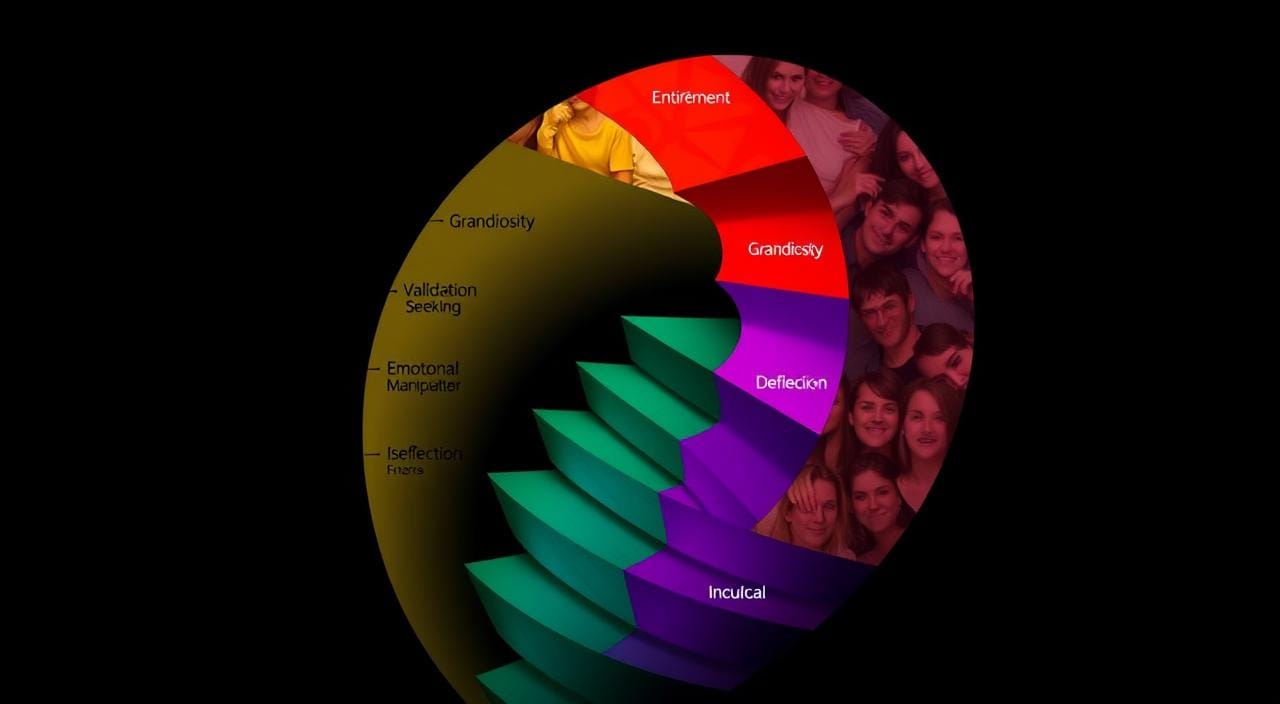Ever felt like your reality was being questioned? Or your emotions dismissed? Or your confidence undermined? If yes, you might have been a victim of gaslighting. But what is gaslighting, and how do we spot and fight this psychological abuse1? Learn how to explain gaslighting to someone?
Gaslighting is when someone makes you doubt your sanity, memories, or what’s real1. It happens in personal and work settings, and even in public1. Gaslighters deny facts, shift blame, or make you doubt yourself to keep control1.
Key Takeaways
- Gaslighting is a form of psychological manipulation that makes you doubt your reality, memories, and self-worth.
- It can happen in personal, work, and public life, with tactics ranging from subtle to obvious.
- Spotting gaslighting signs, like constant doubt and trouble making decisions, is key to fighting it.
- To tackle gaslighting, first identify the issue, then acknowledge your feelings, and seek help from people you trust.
- Looking after your mental health and breaking free from gaslighting is vital to regain your self and freedom from manipulation.
Understanding gaslighting and its tactics helps us spot and fight emotional abuse. This empowers us and others to take back our reality and self-worth12.
What is Gaslighting?
Gaslighting is when someone tries to make you doubt your own thoughts, memories, or feelings3. It comes from a 1938 play and 1944 movie “Gas Light.” In it, a husband makes his wife think she’s losing her mind by changing the gas lights and denying it.
Definition and Origins of the Term
The National Domestic Violence Hotline says gaslighting can be done in many ways. This includes making someone doubt their memory, pretending not to understand, or belittling their feelings. It’s a way to control someone by making them doubt themselves and rely more on the abuser.
Examples of Gaslighting Tactics
- Denying or minimizing the victim’s experiences and emotions
- Accusing the victim of being “too sensitive” or “overreacting”
- Twisting the facts or distorting the truth to confuse the victim
- Withholding important information or refusing to acknowledge the victim’s concerns
- Blaming the victim for the abuser’s own behavior or mistakes
Gaslighting is often used by narcissists, manipulators, and abusers to keep control3. It can really hurt someone’s mental health, causing anxiety, depression, and even suicidal thoughts3.
“Gaslighting is a form of psychological manipulation where a person or entity makes someone question their own reality, perceptions, or memories.”
How to explain gaslighting to someone
Talking about gaslighting can be tricky because it’s about subtle tricks that are hard to spot. It’s best to explain it simply, using examples from before4. Explain how it makes the victim doubt their own reality and feel unsure. Tell them to trust their own feelings and find help from people they can trust.
Being patient and understanding is key when talking about gaslighting. It’s a complex and personal issue. The person might feel confused, unsure, or even doubt their sanity. Let them know their feelings are real and they’re not alone.
- Begin by defining gaslighting clearly. Explain it’s a form of emotional abuse that makes the victim doubt their own reality4.
- Share examples of gaslighting, like denying things happened, blaming others, or making the victim feel crazy4.
- Tell them to trust their instincts and feelings. Remind them their experiences are valid, even if someone else says otherwise5.
- Encourage them to keep a journal or record their interactions. This can help document the gaslighting and build a case for their experience5.
- Offer to help them find resources like support groups or counseling. These can provide more help and guidance5.
Explaining gaslighting isn’t about proving they’re being manipulated. It’s about helping them see the behavior and protect themselves. By understanding gaslighting and believing their experience, they can regain control and start healing45.

Approach the conversation with empathy, patience, and a true desire to help. This will support them in understanding and overcoming gaslighting’s effects5.
Types of Gaslighting
Gaslighting is a way to manipulate others, seen in intimate relationships, domestic violence, and more. It’s important to know the different types to spot and stop this abuse.
In Intimate Relationships
In close relationships, an abusive partner might use gaslighting to control their partner. They might say things like, “You’re being irrational,” to make their partner doubt themselves.
Parent-Child Relationships
Abusive parents or caregivers use gaslighting on children too. For example, they might say a child is “too sensitive” when they cry, to shame them and stop their crying.
Racial Gaslighting
Racial gaslighting targets entire racial or ethnic groups. It’s when someone says an activist is “irrational” or denies biases when confronted about microaggressions.
Workplace Gaslighting
At work, gaslighting happens when someone in power manipulates a subordinate. This can include trivializing their fears or directing negative emotions towards them. It can also happen in institutions, where whistleblowers are called irrational or incompetent.

“Gaslighting is a form of emotional and psychological abuse that is difficult to identify and break free from, requiring time, self-compassion, and professional help.”
Gaslighting includes denying experiences, projecting lies, and blaming the victim. It can be as subtle as using charm or as extreme as violence to control someone. Getting out of gaslighting takes support and sometimes professional help6.
| Types of Gaslighting | Characteristics |
|---|---|
| Unintentional Gaslighting | A common example cited is a parent invalidating a child’s pain to teach not to overreact7. |
| Malicious Gaslighting | Characterized by intentional manipulation, often for control or abusive purposes7. |
- Disbelief
- Defense
- Depression
- “You’re too sensitive”
- “I never said that”
- “I’m not angry”
- “It’s all your fault”
- “You’re emotionally unstable”
- “Nobody likes you”
- “You’re petty”
Signs of Gaslighting
Spotting gaslighting can be hard because victims doubt their own thoughts and memories. This is due to the manipulative ways of the abuser8. Knowing the common signs can help people spot and fight this emotional abuse9.
- Feeling unsure about your own thoughts, emotions, and experiences
- Often doubting if you remember things right
- Thinking you’re “irrational” or “crazy” when you’re not
- Feeling like you’re not good at anything, even when you used to be
- Always saying sorry to the person who’s being abusive, even when you’re right
- Stepping back from friends, family, and other people who support you
Gaslighting starts slowly, making the victim doubt their own reality8. This long-term trickery can make people feel confused, anxious, and dependent on the abuser8.

Gaslighting isn’t just about romantic relationships. It can happen in families or at work too8. Spotting these signs early is key. It helps victims get help and protect themselves9.
“Gaslighting is a form of mental and emotional abuse, where the abuser carries out behaviors slowly and deliberately to make the victim doubt their own reality.”
By knowing the signs of gaslighting, people can start to feel themselves again. They can look for help and break free from the abuse9.
Gathering Evidence
Gathering evidence of gaslighting helps us prove our experiences and protect ourselves10. It confirms our perceptions and memories10. But, confronting a gaslighter directly might not be the best move, as they often resist10. Instead, documenting the abuse and seeking support are better steps.
Keeping a Journal
Keeping a secret journal or diary is a good way to gather evidence10. It lets us record gaslighting incidents, including dates and details. This written record helps us remember and prove our experiences.
Talking to Trusted Individuals
Talking to a trusted friend, family member, or counselor is also helpful10. They can witness the gaslighting and offer emotional support11. It’s important to keep these relationships strong, as gaslighters often try to isolate their victims.
Taking Pictures and Voice Memos
Photographic and audio evidence can also document gaslighting10. Pictures of property damage or injuries can support our claims10. Voice recordings of abusive incidents provide clear proof of the gaslighter’s actions10. Keep this evidence safe and hidden from the gaslighter.
By journaling, talking to trusted people, and recording incidents, we can build a strong case against the gaslighter1011. This helps us protect ourselves from their manipulative tactics1011.

Causes of Gaslighting Behavior
It’s important to know why people gaslight. This behavior can come from mental health issues, personality disorders, or learned behaviors12. Understanding these reasons helps us spot and stop gaslighting.
Gaslighting often comes from a need for power and control. People who gaslight think they can do whatever it takes to win12. They might feel entitled, crave admiration, or think they’re better than others13.
Gaslighting can also be learned from family or social circles14. Those who grew up seeing gaslighting or experienced it themselves might use these tactics14.
People with mental health problems, low self-esteem, or narcissistic traits are more likely to gaslight14. They might deny their actions, shift blame, or enjoy making others suffer14. This behavior can be very harmful.
Knowing why gaslighting happens is the first step to stopping it. By understanding the reasons, we can protect ourselves and help others13.
Remember, anyone can gaslight, not just those with mental health issues. Being aware of the signs is key to keeping ourselves safe in all areas of life13.
Protecting Yourself from Gaslighting
Dealing with gaslighting can be tough, but there are ways to protect yourself. Safety planning and self-care are key to helping those who have been abused.
Safety Planning
Safety plans help keep you safe from gaslighting turning violent15. Your plan might list safe places, escape routes, emergency contacts, and self-care ideas. If you’re being abused, getting help is vital to avoid worse harm.
Self-Care Strategies
Self-care is vital for your mental and emotional health after gaslighting16. Talk to a therapist who knows about abusive relationships. Yoga, meditation, exercise, and hobbies can also help keep your mind clear and strong.
It’s important to protect yourself from gaslighting’s harm17. With a safety plan and self-care, you can take charge of your well-being and feel in control again.
“Holding on to the truth and resisting gaslighting tactics can reduce self-doubt and empower individuals in intimate relationships.”15
You’re not alone in fighting gaslighting. Getting support and resources is crucial in overcoming it and finding yourself again.
Gender and Gaslighting
Gaslighting is a form of emotional abuse that shows up differently based on gender. Research shows it happens most in heterosexual relationships, with a man often gaslighting a woman18. Men use gender stereotypes to make their female partners doubt themselves, saying women are irrational or emotional18. Women’s looks and sex lives are also common targets for gaslighting.
Gaslighting in Medicine
Gender bias affects women in healthcare too. Doctors might say women are too emotional to listen to their health concerns18. This can stop women from getting the care they need.
Public or Collective Gaslighting
Gaslighting isn’t just about personal relationships. It can happen in public too. When public figures or people online share false information, it can make women doubt themselves18. This can really hurt women’s self-confidence and trust in their own experiences.
In short, gender and gaslighting are closely tied. Men often use stereotypes to gaslight women18. This problem isn’t just in personal relationships; it also happens in healthcare and public spaces18. It’s important to understand how gender plays a role in gaslighting to fight this abuse and create fairer relationships and societies.
Gaslighting and Mental Health
Gaslighting is a harmful form of emotional abuse that can severely affect a person’s mental health. Studies show that gaslighting is a form of manipulation that can make a person doubt their own thoughts and feelings19.
The mental health effects of gaslighting can be severe. Victims may lose confidence, feel hopeless, or become emotionally numb19. They might start making choices to please others, constantly apologize, or even isolate themselves from friends and family19.
Gaslighting can take many forms, like denying events or making the victim feel too sensitive19. It happens in many places, including in relationships, medical settings, and even at work20.
| Type of Gaslighting | Characteristics |
|---|---|
| Intimate Partner Relationships | Emotional abuse based on inequality and gender-based stereotypes20 |
| Racial Gaslighting | Diminishing experiences with racism20 |
| Medical Gaslighting | Dismissing patients’ symptoms, disproportionately affecting women20 |
| Political Gaslighting | Manipulating public opinion on political matters20 |
Getting help from a therapist or counselor who knows about abusive relationships is key. They can help address the mental health issues caused by gaslighting. It’s also important to seek outside help and keep records of interactions19.
“Gaslighting is a highly calculated form of manipulation carried out by someone in a position of trust usually over an extended period of time.”21
As the word of the year in 2022 and with a 1,740% increase in searches21, it’s clear that gaslighting’s impact on mental health is a big issue. We need more awareness and support.
Conclusion
Gaslighting is a complex form of psychological manipulation that affects mental health and relationships22. It’s found in many places, from personal relationships to work23. Knowing how to spot gaslighting tactics like lying and denying feelings is key to protecting ourselves and our loved ones.
Recovering from gaslighting is tough, but it’s doable22. Victims can start by gathering proof, finding support, and focusing on self-care24. This helps them regain their sense of self and break free from manipulation.
In summary, understanding gaslighting means recognizing its signs, its common occurrence, and the need for self-empowerment and support23. By staying alert, getting help when needed, and believing in our strength, we can fight against emotional abuse. This way, we create a society that supports those affected by gaslighting. You can share your thoughts on how to explain gaslighting to someone.
FAQ
What is gaslighting?
Gaslighting is a form of psychological abuse. It makes someone doubt their sanity, memories, or reality. Tactics like countering, withholding, and denial are used to make the victim question themselves.
Where does the term “gaslighting” come from?
The term “gaslighting” comes from a 1938 play and its 1944 film. In it, a husband tries to make his wife think she’s losing her mind. He does this by changing the gas lights and denying it.
What are some examples of gaslighting tactics?
Gaslighting tactics include countering, withholding, and trivializing. Denial and diverting are also used. These tactics aim to make the victim doubt themselves.
How can I explain gaslighting to someone?
Explain gaslighting clearly. Describe the tactics used, like countering and denial. Tell them it undermines confidence and trust. Encourage them to trust themselves and seek support.
Where does gaslighting commonly occur?
Gaslighting is common in intimate relationships. An abusive partner may use it to control their partner. It also happens in parent-child relationships and the workplace.
What are the signs of gaslighting?
Signs include doubting one’s perceptions and questioning memories. Feeling irrational or “crazy” is common. So is feeling incompetent or worthless.
How can I gather evidence of gaslighting?
Keep a diary or journal. Talk to trusted friends or family. Take photos and record voices. This evidence helps prove things aren’t imagined.
What causes someone to engage in gaslighting?
Gaslighting is often learned behavior. People who gaslight may crave admiration and attention. They may also believe they’re special or better than others.
How can I protect myself from gaslighting?
Create a safety plan with safe places and emergency contacts. Seek help from a therapist who knows about abusive relationships. This helps with the mental health effects.
How does gender play a role in gaslighting?
Gaslighting often happens in heterosexual relationships, with men gaslighting women. Men use gender stereotypes to control their partners. Women can also be gaslighted by doctors or in public.
How does gaslighting impact mental health?
Gaslighting can make someone doubt themselves and feel uncertain. It can lead to low self-esteem and make trusting oneself hard.
Source Links
- https://www.nbcnews.com/better/health/what-gaslighting-how-do-you-know-if-it-s-happening-ncna890866 – What is gaslighting?
- https://www.simplypsychology.org/what-is-gaslighting.html – What Is Gaslighting? Examples, Types, Causes, & How To Respond
- https://www.newportinstitute.com/resources/mental-health/what_is_gaslighting_abuse/ – Identifying Gaslighting: Signs, Examples, and Seeking Help
- https://www.vox.com/first-person/2018/12/19/18140830/gaslighting-relationships-politics-explained – “I’ve counseled hundreds of victims of gaslighting. Here’s how to spot if you’re being gaslighted.”
- https://hilarycorna.com/what-is-gaslighting-and-how-to-know-if-youre-doing-it/ – What is Gaslighting and How to Know if You’re Doing it
- https://www.sacap.edu.za/blog/applied-psychology/types-of-gaslighting/ – Understanding Abuse: Types of Gaslighting
- https://www.commonego.com/blog/gaslighting-types-phases-phrases-don-t-fall-for-these-gaslighting-tactics – GASLIGHTING TYPES, PHASES & PHRASES: Don’t Fall for these Gaslighting Tactics
- https://www.verywellmind.com/is-someone-gaslighting-you-4147470 – Watch Out for These 8 Gaslighting Behaviors
- https://www.grampian-womens-aid.com/newsevents/gaslighting-10-signs/ – Coercive Control: 10 Signs It’s Gaslighting
- https://www.simplypsychology.org/how-to-expose-a-gaslighter.html – How to Expose a Gaslighter
- https://www.medicalnewstoday.com/articles/how-to-deal-with-gaslighting – How to deal with gaslighting: 8 tips
- https://www.simplypsychology.org/why-do-people-gaslight.html – Why Do People Gaslight?
- https://www.medicalnewstoday.com/articles/gaslighting – What is gaslighting? Examples and how to respond
- https://focusmw.com/mental-health-issues/gaslighting/ – All About Gaslighting: Reasons Why People Manipulate & Signs to Watch Out For – Focus Mental Wellness
- https://www.psychologytoday.com/us/blog/mind-games/201904/gaslighting-in-relationships-seven-ways-protect-yourself – Gaslighting in Relationships: Seven Ways to Protect Yourself
- https://www.mga.edu/news/2023/04/what-is-gaslighting-and-how-to-fight-back.php – Gaslighting: What Is It And How Do We Fight Back?: Middle Georgia State University
- https://www.helpguide.org/relationships/domestic-abuse/gaslighting – Gaslighting: What is It and How to Stop It
- https://www.asanet.org/wp-content/uploads/attach/journals/oct19asrfeature.pdf – The Sociology of Gaslighting
- https://www.healthline.com/health/gaslighting – Gaslighting: Signs and Tips to Manage
- https://www.everydayhealth.com/emotional-health/gaslighting-what-it-is-and-how-to-know-its-happening-to-you/ – Gaslighting: What It Is and How to Know if It’s Happening to You
- https://www.cnn.com/2023/08/07/health/gaslighting-meaning-examples-relationships-wellness/index.html – What gaslighting really is, and how to know if you’re experiencing it | CNN
- https://www.tero.com/articles/gaslighting.php – Tero Article | Gaslighting: A Hidden Psychological Abuse
- https://medium.com/@katiabeeden/what-is-gaslighting-and-how-to-know-when-its-been-done-to-you-e9d104b5dd04 – What Is Gaslighting And How To Know When It’s Been Done To You.
- https://www.goodtherapy.org/blog/psychpedia/gaslighting/ – Gaslighting – GoodTherapy.org Therapy Blog







